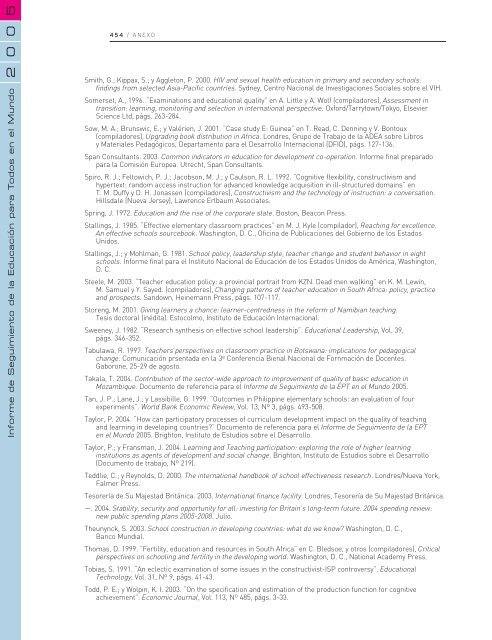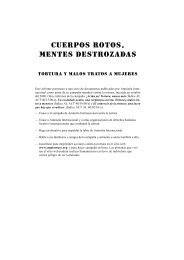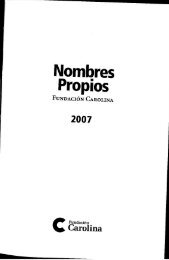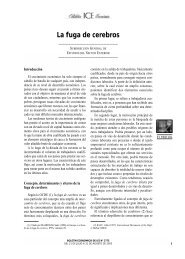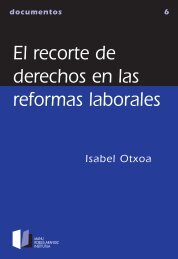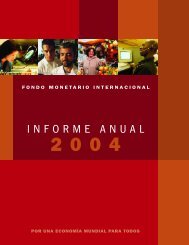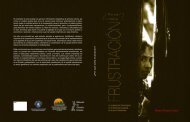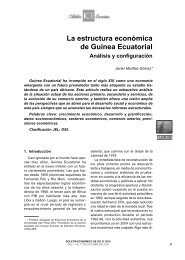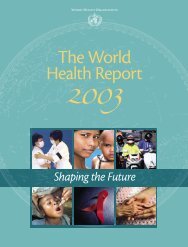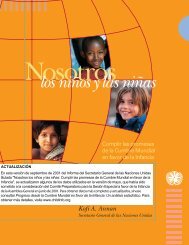Educación para todos: el imperativo de la calidad; Informe ... - eFaber
Educación para todos: el imperativo de la calidad; Informe ... - eFaber
Educación para todos: el imperativo de la calidad; Informe ... - eFaber
- No tags were found...
You also want an ePaper? Increase the reach of your titles
YUMPU automatically turns print PDFs into web optimized ePapers that Google loves.
005454 / ANEXO2<strong>Informe</strong> <strong>de</strong> Seguimiento <strong>de</strong> <strong>la</strong> Educación <strong>para</strong> Todos en <strong>el</strong> MundoSmith, G.; Kippax, S.; y Aggleton, P. 2000. HIV and sexual health education in primary and secondary schools:findings from s<strong>el</strong>ected Asia-Pacific countries. Sydney, Centro Nacional <strong>de</strong> Investigaciones Sociales sobre <strong>el</strong> VIH.Somerset, A., 1996. “Examinations and educational quality” en A. Little y A. Wolf (compi<strong>la</strong>dores), Assessment intransition: learning, monitoring and s<strong>el</strong>ection in international perspective. Oxford/Tarrytown/Tokyo, ElsevierScience Ltd, págs. 263-284.Sow, M. A.; Brunswic, E.; y Valérien, J. 2001. “Case study E: Guinea” en T. Read, C. Denning y V. Bontoux(compi<strong>la</strong>dores), Upgrading book distribution in Africa. Londres, Grupo <strong>de</strong> Trabajo <strong>de</strong> <strong>la</strong> ADEA sobre Librosy Materiales Pedagógicos, Departamento <strong>para</strong> <strong>el</strong> Desarrollo Internacional (DFID), págs. 127-136.Span Consultants. 2003. Common indicators in education for <strong>de</strong>v<strong>el</strong>opment co-operation. <strong>Informe</strong> final pre<strong>para</strong>do<strong>para</strong> <strong>la</strong> Comisión Europea. Utrecht, Span Consultants.Spiro, R. J.; F<strong>el</strong>towich, P. J.; Jacobson, M. J.; y Caulson, R. L. 1992. “Cognitive flexibility, constructivism andhypertext: random access instruction for advanced knowledge acquisition in ill-structured domains” enT. M. Duffy y D. H. Jonassen (compi<strong>la</strong>dores), Constructivism and the technology of instruction: a conversation.Hillsdale (Nueva Jersey), Lawrence Erlbaum Associates.Spring, J. 1972. Education and the rise of the corporate state. Boston, Beacon Press.Stallings, J. 1985. “Effective <strong>el</strong>ementary c<strong>la</strong>ssroom practices” en M. J. Kyle (compi<strong>la</strong>dor), Reaching for exc<strong>el</strong>lence.An effective schools sourcebook. Washington, D. C., Oficina <strong>de</strong> Publicaciones d<strong>el</strong> Gobierno <strong>de</strong> los EstadosUnidos.Stallings, J.; y Mohlman, G. 1981. School policy, lea<strong>de</strong>rship style, teacher change and stu<strong>de</strong>nt behavior in eightschools. <strong>Informe</strong> final <strong>para</strong> <strong>el</strong> Instituto Nacional <strong>de</strong> Educación <strong>de</strong> los Estados Unidos <strong>de</strong> América, Washington,D. C.Ste<strong>el</strong>e, M. 2003. “Teacher education policy: a provincial portrait from KZN. Dead men walking” en K. M. Lewin,M. Samu<strong>el</strong> y Y. Sayed. (compi<strong>la</strong>dores), Changing patterns of teacher education in South Africa: policy, practiceand prospects. Sandown, Heinemann Press, págs. 107-117.Storeng, M. 2001. Giving learners a chance: learner-centredness in the reform of Namibian teaching.Tesis doctoral (inédita). Estocolmo, Instituto <strong>de</strong> Educación Internacional.Sweeney, J. 1982. “Research synthesis on effective school lea<strong>de</strong>rship”. Educational Lea<strong>de</strong>rship, Vol. 39,págs. 346-352.Tabu<strong>la</strong>wa, R. 1997. Teachers’perspectives on c<strong>la</strong>ssroom practice in Botswana: implications for pedagogicalchange. Comunicación prsentada en <strong>la</strong> 3 e Conferencia Bienal Nacional <strong>de</strong> Fornmación <strong>de</strong> Docentes.Gaborone, 25-29 <strong>de</strong> agosto.Taka<strong>la</strong>, T. 2004. Contribution of the sector-wi<strong>de</strong> approach to improvement of quality of basic education inMozambique. Documento <strong>de</strong> referencia <strong>para</strong> <strong>el</strong> <strong>Informe</strong> <strong>de</strong> Seguimiento <strong>de</strong> <strong>la</strong> EPT en <strong>el</strong> Mundo 2005.Tan, J. P.; Lane, J.; y Lassibille, G. 1999. “Outcomes in Philippine <strong>el</strong>ementary schools: an evaluation of fourexperiments”. World Bank Economic Review, Vol. 13, Nº 3, págs. 493-508.Taylor, P. 2004. “How can participatory processes of curriculum <strong>de</strong>v<strong>el</strong>opment impact on the quality of teachingand learning in <strong>de</strong>v<strong>el</strong>oping countries?” Documento <strong>de</strong> referencia <strong>para</strong> <strong>el</strong> <strong>Informe</strong> <strong>de</strong> Seguimiento <strong>de</strong> <strong>la</strong> EPTen <strong>el</strong> Mundo 2005. Brighton, Instituto <strong>de</strong> Estudios sobre <strong>el</strong> Desarrollo.Taylor, P.; y Fransman, J. 2004. Learning and Teaching participation: exploring the role of higher learninginstitutions as agents of <strong>de</strong>v<strong>el</strong>opment and social change. Brighton, Instituto <strong>de</strong> Estudios sobre <strong>el</strong> Desarrollo(Documento <strong>de</strong> trabajo, Nº 219).Teddlie, C.; y Reynolds, D. 2000. The international handbook of school effectiveness research. Londres/Nueva York,Falmer Press.Tesorería <strong>de</strong> Su Majestad Británica. 2003. International finance facility. Londres, Tesorería <strong>de</strong> Su Majestad Británica.—. 2004. Stability, security and opportunity for all: investing for Britain’s long-term future. 2004 spending review:new public spending p<strong>la</strong>ns 2005-2008. Julio.Theunynck, S. 2003. School construction in <strong>de</strong>v<strong>el</strong>oping countries: what do we know? Washington, D. C.,Banco Mundial.Thomas, D. 1999. “Fertility, education and resources in South Africa” en C. Bledsoe, y otros (compi<strong>la</strong>dores), Criticalperspectives on schooling and fertility in the <strong>de</strong>v<strong>el</strong>oping world. Washington, D. C., National Aca<strong>de</strong>my Press.Tobias, S. 1991. “An eclectic examination of some issues in the constructivist-ISP controversy”. EducationalTechnology, Vol. 31, Nº 9, págs. 41-43.Todd, P. E.; y Wolpin, K. I. 2003. “On the specification and estimation of the production function for cognitiveachievement”. Economic Journal, Vol. 113, Nº 485, págs. 3-33.


